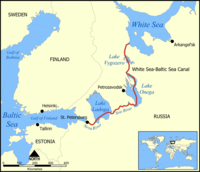
Photo from wikipedia
ABSTRACT This study describes seasonal water quality parameters measured in Petrozavodsk Bay, Lake Onego, Russia. Petrozavodsk Bay (PB) lies in the north of Lake Onego and adjacent to the city… Click to show full abstract
ABSTRACT This study describes seasonal water quality parameters measured in Petrozavodsk Bay, Lake Onego, Russia. Petrozavodsk Bay (PB) lies in the north of Lake Onego and adjacent to the city of Petrozavodsk. PB water quality is controlled by anthropogenic input, inflow of the Shuya River, and water exchange with open areas of the greater Lake Onego. We measured ion composition, organic matter, nutrients, gas composition, trace elements, and mercury throughout 2016, to evaluate PB water quality. Elevated humic content and organic matter, including total organic carbon (TOC = 17.0 mg L−1), total phosphorus (TP = 36 µg L−1), and water color (134 mg Pt L−1), demonstrated the eutrophic character of Shuya River input. Low humic and organic matter content (TOC = 6.5 mg L−1, TP = 7 µg L−1, water color = 26 mg Pt L−1) indicated the oligotrophic character of open lake waters. During winter, the PB hydrochemical regime was primarily controlled by Shuya River inflow because water exchange between the bay and open lake was restricted during its ice-covered period. As a result, PB chemical indices varied considerably. TOC varied from 7.6 to 17.8 mg L−1, TP from 7 to 55 µg L−1, and О2 from 69% to 87% saturation during this period. Total filterable mercury concentrations (THg = inorganic mercury plus methylmercury) at all measurement sites remained low. Overall, these results help constrain understanding of lake dynamics, anthropogenic influence, and river input to the lake during ice-covered periods.
Journal Title: Inland Waters
Year Published: 2019
Link to full text (if available)
Share on Social Media: Sign Up to like & get
recommendations!